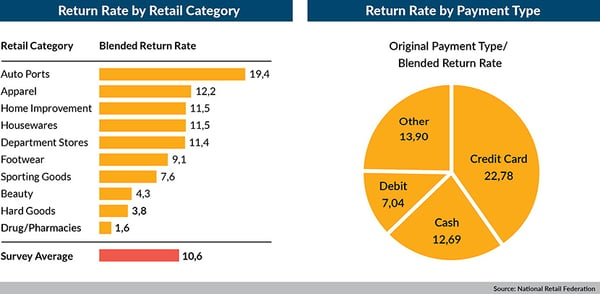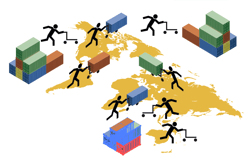5 Reasons Better Returns Deserve Top Priority
Keith LaBotz - June 17, 2022

Increasing the rate of return is usually a good thing for a business unless we’re talking about logistics. Product returns reduce profit, and the problem will likely worsen for companies lacking effective reverse logistics processes.
There will be no opting out of what lies ahead for supply chains with multiple trends pushing return rates higher:
- Continued expansion of e-commerce.
- Increasing capabilities from digitalization.
- Growing demand for sustainability.
- Rising customer expectations.
- New logistics strategies for mitigating globalization risks.
The problem with returns goes beyond returns. A Gartner survey found only 27% of respondents claimed to use digital technologies to improve reverse logistics, and 39% claimed they would follow in two years. This lackluster response suggests something is holding companies back from the rewards of effective reverse logistics.
Knowing why returns deserve a high priority and the challenges preventing others from improving the process can give your company an advantage.
Returns Are A Bigger Problem Than They Appear
Is the problem of returns significant enough to justify automating the process? To answer that, let’s go to ground zero for returns: retail distribution.
Supply chains organize around meeting customer demand and delivering goods to the customer, so their effectiveness is primarily a measure of delivery performance. Whatever happens at the point of delivery, the good and the bad experiences can ultimately be traced upstream in a supply chain to its cause.
According to National Retail Federation, returns shot up from 10.6 percent of sales in 2020 to 16.6 percent in 2021. That’s $761 billion of returned merchandise in the U.S. alone - more than the U.S. Federal Government spent on Defense in 2020. A considerable loss that’s not just a problem for retailers; the supply chain that delivered the goods must either fix the problem causing returns or take them back with all the incumbent costs.
 Source: National Retail Federation
Source: National Retail Federation
-
Automotive parts experience the highest rate of returns, with nearly one of every five shipments bouncing back.
-
The average retailer has $166 million in returns for every $1 billion in sales.
-
Online orders have higher rates of return and are a significant driver of returns.
Returns Disrupt Supply Chains
Returns are supply chain disruptions, which consume more resources and degrade logistics performance.
Two years of fighting a supply chain wildfire have burned one thing into the minds of supply chain professionals: disruptions travel through the entire supply chain, negatively impacting every party in the network. Unmanaged returns divert resources from more productive tasks, and these interruptions collectively degrade the performance of a supply chain network.
Returns Introduce Hidden Costs
For the individual business, the cost of returns goes beyond a lost sale reducing income. Returns also increase the Cost of Goods thru:
-
Higher labor costs from extra material handling, inspection, and re-stocking.
-
Losses from markdowns, out-of-stocks, and inventory carrying costs.
Quantifying and minimizing these costs requires data collection and visibility - a structured process for managing incoming returns. Without this visibility, returns remain an unmanageable hidden cost.
Returns Solutions Are More Difficult
Many companies understand the need for a returns process but move on to other solutions upon realizing that returns are more complex than fulfillment logistics.
For this reason, shippers and software developers overwhelmingly tilt process improvements to fulfillment. Consequently, outbound shipping operations tend to be far more efficient than inbound supply chains. Several factors perpetuate this unbalanced approach to logistics:
-
Most companies' return rates range from single to low double digits, so concentrating on outbound shipping is warranted.
-
Process improvements to forwarding logistics are much easier to make as the assets are under the control of the enterprise.
-
Reverse depends on collaboration with external trading partners that may number in the hundreds or thousands for the typical company.
Returns Enlarge Carbon Footprints
The transportation, material handling, inspection, and re-stocking associated with returns means more energy is consumed to process returns. Depending on the distribution network and product, these activities may be repeated by multiple parties in the supply chain, each enlarging the carbon footprint for the returned SKU.
Additionally, inbound freight management processes are typically less efficient than fulfillment logistics. The less efficient reverse logistics processes consume more energy and generate higher emissions than the more efficient forward logistics.
How to Solve Returns Problems
Transportation is the core of every supply chain, so an effective returns process depends on an effective transportation process. The more optimized a company’s transportation process is, the more effective its reverse logistics process will be.
Measuring and managing return disruptions requires a process with end-to-end visibility that begins with the pickup of a return from the customer. A solution that provides customers with an automated shipping process for returns maximizes compliance and control over returns. This is the easiest way to overcome previously mentioned obstacles for logistics operations managing a private transportation fleet.
One solution that satisfies these requirements is flexis ProfiTOUR. ProfiTOUR optimizes vehicle routing, producing automated pickup and delivery plans for corporate transportation fleets.
-
Transportation operations can rapidly deploy ProfiTOUR to manage the pickup of large and small items returned by customers.
-
The recipient gains real-time visibility to incoming returns so warehouses receiving them can automate the returns process.
-
ProfiTOUR optimizes profitability and minimizes the carbon footprint of every pickup. This ensures sustainability goals are met while keeping returns processing costs to a minimum.
Conclusion
flexis ProfiTOUR eliminates the barriers preventing most companies from effectively managing returns. Transportation fleets use ProfiTOUR to optimize delivery operations and automate returns with virtually no additional effort.
You want more information ?
LATEST POSTS
- Understand Circular Economy in The Manufacturing Industry
- How Can Industry 4.0 IT Integration Be Achieved Smoothly?
- The Significance of Order Sequencing in Discrete Manufacturing
- How to improve your Supply Chain Management: The Power of Control Towers
- Optimizing Human Resource Scheduling in Manufacturing: A Technological Approach



